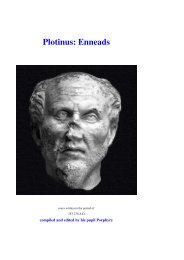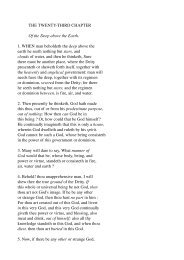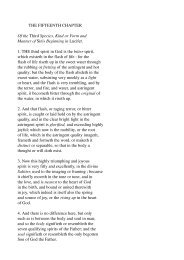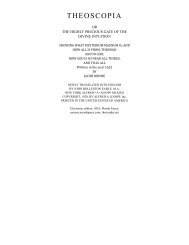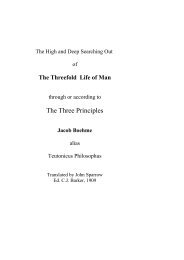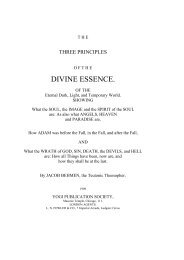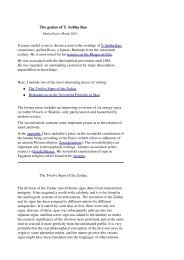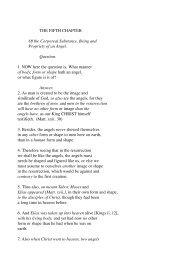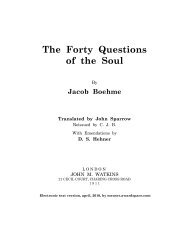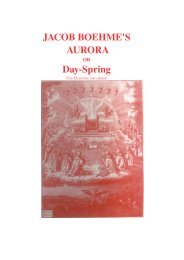Gerald Massey's Lectures - Society in evolution - Awardspace
Gerald Massey's Lectures - Society in evolution - Awardspace
Gerald Massey's Lectures - Society in evolution - Awardspace
You also want an ePaper? Increase the reach of your titles
YUMPU automatically turns print PDFs into web optimized ePapers that Google loves.
of the light and dark tw<strong>in</strong>s were certa<strong>in</strong>ly cont<strong>in</strong>ued as the two-fold Christ <strong>in</strong> Rome, one<br />
form of whom is the little black Bamb<strong>in</strong>o of Italy, the Christ who was black for the same<br />
reason that Sut was black <strong>in</strong> Egypt, and Krishna was blue-black <strong>in</strong> India. He was black,<br />
because mythical, and not because the Word was humanly <strong>in</strong>carnated as a nigger! He was<br />
black because he was the child of the virg<strong>in</strong>-mother as the moon!<br />
One type of the tw<strong>in</strong>s found <strong>in</strong> the lunar phenomena has been humanised <strong>in</strong> the story of<br />
Jesus and John; these can be traced back to Horus and Sut, who is Aan or Anup, the<br />
Egyptian John. These two appear <strong>in</strong> the Ritual as the "Precursor," and the one who is<br />
preferred to him who was first <strong>in</strong> com<strong>in</strong>g. Speak<strong>in</strong>g <strong>in</strong> the tw<strong>in</strong> character, the Osirified<br />
deceased says, "I am Anup <strong>in</strong> the day of judgment. I am Horus, the Preferred, on the day<br />
of ris<strong>in</strong>g." Anup presided over the judgment; so John the Precursor proclaims the<br />
judgment; and calls the world to repentance. Jesus comes as the "preferred one" on the<br />
day of his ris<strong>in</strong>g up out of the waters, when John the Precursor says of Jesus, "After me<br />
cometh a man which is become before me!" John's was the voice of one cry<strong>in</strong>g <strong>in</strong> the<br />
wilderness, "Make ye ready the way of the Lord." "I make way," says Horus, "by what<br />
Anup (the Precursor) has done for me." The tw<strong>in</strong> lunar characters of John and Jesus can<br />
be identified <strong>in</strong> the gospel where John says of Jesus "He must <strong>in</strong>crease, but I must<br />
decrease." So the title of the Akkadian moon-god, S<strong>in</strong>, as the <strong>in</strong>creaser of light, is Enuzuna,<br />
the Lord of wax<strong>in</strong>g. In the Mithraic mysteries the light one of the tw<strong>in</strong>s was<br />
designated the bridegroom, and <strong>in</strong> one passage we meet with the bridegroom and the<br />
bride, that is the lunar mother of the Tw<strong>in</strong>s and Christ as the bridegroom. John personates<br />
the dark one; like Sut-Anup, he is not the light itself, and only bears witness to the light.<br />
The Christ or Horus was consort to the mother-moon, and the reproducer of himself. John<br />
says of him, "He that hath the bride is the bridegroom; but the friend of the bridegroom<br />
which standeth and heareth him rejoiceth greatly because of the bridegroom's voice."<br />
These three, the bride, bridegroom, and John, are a perfect replica of the lunar Tr<strong>in</strong>ity.<br />
John represents the dark half of the moon, the child of the mother only, and he is<br />
unmistakably identified by Jesus <strong>in</strong> or as this mythical character when he says of his forerunner,<br />
"Among them that are born of woman there is none greater than John, yet, he that<br />
is but little <strong>in</strong> the k<strong>in</strong>gdom of God is greater than he;" that is, among those who are reborn<br />
<strong>in</strong> the likeness of the father, as Horus was when the solar god re-begot him <strong>in</strong> his<br />
own image as the reflection of his hidden glory reproduced by the new moon--the least of<br />
these is greater than he who was born of the mother alone.<br />
As we have seen, the fox and jackal were both of them Typhonian types of the dark<br />
power, the thief of light <strong>in</strong> the moon, and co-types, therefore, with the dragon that<br />
swallowed the moon dur<strong>in</strong>g an eclipse. Now, the name of Herod <strong>in</strong> Syriac denotes a red<br />
dragon; and the red dragon <strong>in</strong> Revelation, which stands ready to devour the young child<br />
that is about to be born, is the mythical form of the Herod who has been made historical<br />
<strong>in</strong> our gospels. Here the legendary devourer, the dark half of the lunation. The Germans<br />
have a say<strong>in</strong>g that the wolf is eat<strong>in</strong>g the candle when there is what is still called a thief <strong>in</strong><br />
it. So the primitive observers saw the dark encroach<strong>in</strong>g on the light, and they said the<br />
wolf, jackal, rat, or other sly animal was eat<strong>in</strong>g the moon as the thief of its light. This is<br />
why Hermes was represented as the thief. In two different forms of the lunar mythos the<br />
jackal and the dog-headed ape were two types of this thief of the light. And <strong>in</strong> the zodiac<br />
of Denderah, just where Horus is on the cross, or at the cross<strong>in</strong>g of the vernal equ<strong>in</strong>ox,<br />
these two thieves, Sut-Anup and Aan, are depicted one on either side of the luni-solar<br />
god. These two mythical orig<strong>in</strong>als have, I th<strong>in</strong>k, been cont<strong>in</strong>ued and humanised as the<br />
two thieves <strong>in</strong> the Gospel version of the crucifixion.<br />
The character of the thief still cl<strong>in</strong>gs to the man <strong>in</strong> the moon. In a North Frisian folk-tale<br />
the man <strong>in</strong> the moon is fabled to have stolen branches of willow, or the sallow-palms,<br />
which he has to carry <strong>in</strong> his hands forever. Here we can identify the palm-branch of the<br />
man <strong>in</strong> the moon as Egyptian. The palm-branch was a type of time and periodicity. Hor-



